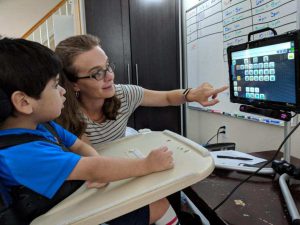 I was recently able to attend the Council for Exceptional Children’s National Conference in Indiana. I love being able to hear about current research, connect with educators, and learn new strategies and techniques. This year I was thrilled to see a session titled “Instructional Decision Making: Students Who Use AAC: What Do the Experts Say?” Perfect! I thought. I’ll learn what the research says and come away with some specific, concrete ideas to apply to my work with Joey.
I was recently able to attend the Council for Exceptional Children’s National Conference in Indiana. I love being able to hear about current research, connect with educators, and learn new strategies and techniques. This year I was thrilled to see a session titled “Instructional Decision Making: Students Who Use AAC: What Do the Experts Say?” Perfect! I thought. I’ll learn what the research says and come away with some specific, concrete ideas to apply to my work with Joey.
Interestingly enough, this is the opposite of what happened. The research team presenting shared that their original plan was to research how to support para-professionals when they are interacting with children using AAC devices. Quickly into their work they realized they couldn’t come to consensus among themselves of what to teach the para-professionals. If a group of university professors could not identify best practice for AAC devices, who could? Their research changed at this point to look more at current decision making practices in the field, and how teams are teaching and supporting students in their use of AAC.
Their findings?
There are currently few guidelines available to support the decision making process of selecting when and if to introduce a device, and how to teach or support the student’s communication. Practitioners are in conflict over which communication skills to target first, and even what assessment information to use when considering how and when to use a device.
This surprised many of us in the audience, except the findings rang true with our experiences. We could each relate to the debate of discussing with teams which device to use, whether we should use behavioral approaches to introduce new vocabulary and to teach the use of the device, or to approach the instruction from a developmental method. If you gather a team together to discuss using an AAC device, you are likely to hear the same discussions.
While it would be nice to have more concrete research into the hows and whys of using an AAC device, this was a good reminder in the importance of collaboration. In order to make the best decisions for a child we need to gather a team together, truly look at the child’s abilities and needs, and consider multiple possibilities. Without a set guideline we can do our best work by frequently communicating with parents and other practitioners, and constantly reflecting on the student’s growth.
For me, it was a good reminder to keep an open mind with all aspects of the AAC device. There isn’t one right answer out there, so let’s keep our work Joey-focused and always be asking if what we are doing is working for Joey in the moment and if it will support his future communication growth.


